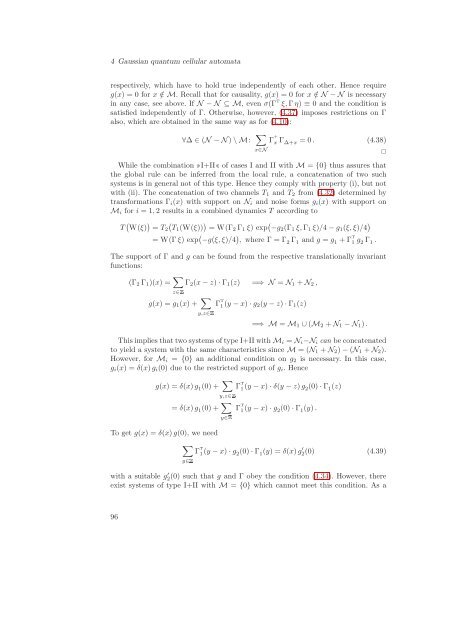Quantum Information Theory with Gaussian Systems
Quantum Information Theory with Gaussian Systems
Quantum Information Theory with Gaussian Systems
You also want an ePaper? Increase the reach of your titles
YUMPU automatically turns print PDFs into web optimized ePapers that Google loves.
4 <strong>Gaussian</strong> quantum cellular automata<br />
respectively, which have to hold true independently of each other. Hence require<br />
g(x) = 0 for x /∈ M. Recall that for causality, g(x) = 0 for x /∈ N − N is necessary<br />
in any case, see above. If N − N ⊆ M, even σ(Γ T ξ, Γ η) ≡ 0 and the condition is<br />
satisfied independently of Γ. Otherwise, however, (4.37) imposes restrictions on Γ<br />
also, which are obtained in the same way as for (4.10):<br />
∀∆ ∈ (N − N) \ M: <br />
x∈N<br />
Γ +<br />
x Γ ∆+x = 0 . (4.38)<br />
While the combinationI+IIof cases I and II <strong>with</strong> M = {0} thus assures that<br />
the global rule can be inferred from the local rule, a concatenation of two such<br />
systems is in general not of this type. Hence they comply <strong>with</strong> property (i), but not<br />
<strong>with</strong> (ii). The concatenation of two channels T1 and T2 from (4.32) determined by<br />
transformations Γi(x) <strong>with</strong> support on Ni and noise forms gi(x) <strong>with</strong> support on<br />
Mi for i = 1, 2 results in a combined dynamics T according to<br />
T W(ξ) <br />
= T2 T1(W(ξ)) = W(Γ2 Γ1 ξ) exp −g2(Γ1 ξ, Γ1 ξ)/4 − g1(ξ, ξ)/4 <br />
= W(Γ ξ) exp −g(ξ, ξ)/4 , where Γ = Γ 2 Γ 1 and g = g 1 + Γ T<br />
1 g 2 Γ 1 .<br />
The support of Γ and g can be found from the respective translationally invariant<br />
functions:<br />
(Γ2 Γ1)(x) = <br />
− z) · Γ1(z) =⇒ N = N1 + N2 ,<br />
z∈Γ2(x<br />
g(x) = g1(x) + <br />
1(y − x) · g2(y − z) · Γ1(z)<br />
y,z∈Γ T<br />
=⇒ M = M1 ∪ (M2 + N1 − N1).<br />
This implies that two systems of type I+II <strong>with</strong> Mi = Ni−Ni can be concatenated<br />
to yield a system <strong>with</strong> the same characteristics since M = (N1 + N2) − (N1 + N2).<br />
However, for Mi = {0} an additional condition on g2 is necessary. In this case,<br />
gi(x) = δ(x)gi(0) due to the restricted support of gi. Hence<br />
g(x) = δ(x)g 1 (0) + <br />
= δ(x)g 1 (0) + <br />
To get g(x) = δ(x)g(0), we need<br />
<br />
y,z∈Γ T<br />
1 (y − x) · δ(y − z)g2 (0) · Γ1 (z)<br />
y∈Γ T<br />
1 (y − x) · g2 (0) · Γ1 (y).<br />
y∈Γ T<br />
1 (y − x) · g 2 (0) · Γ 1 (y) = δ(x)g′ 2<br />
<br />
(0) (4.39)<br />
<strong>with</strong> a suitable g ′ 2 (0) such that g and Γ obey the condition (4.34). However, there<br />
exist systems of type I+II <strong>with</strong> M = {0} which cannot meet this condition. As a<br />
96
















